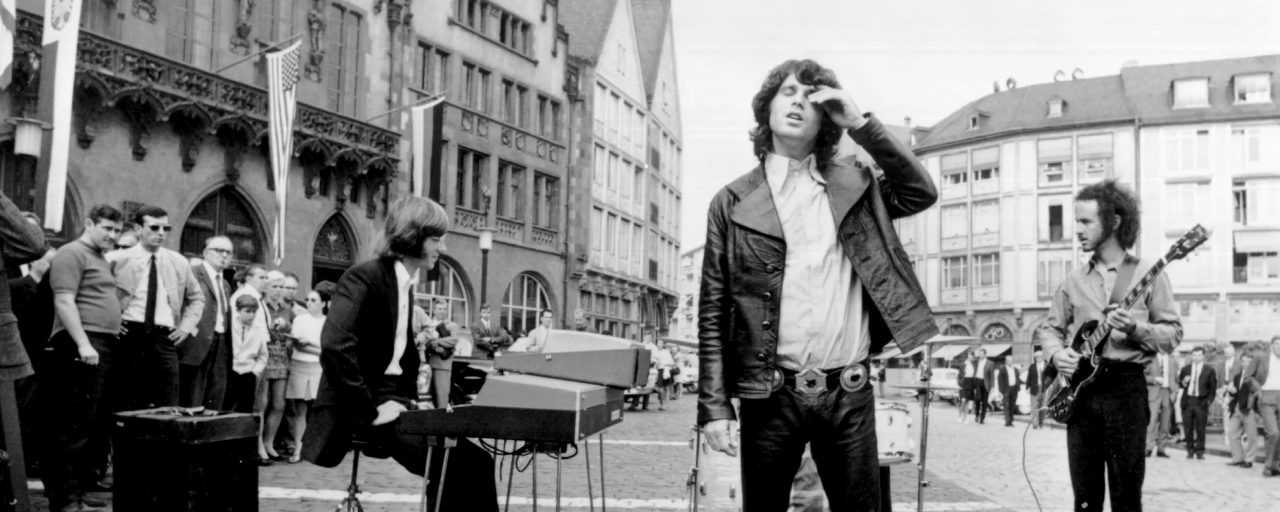⚡ The Song That Opened the Doors
January 1967.
A haunting organ riff.
A relentless drumbeat.
And Jim Morrison whispering like a preacher in a trance:
“You know the day destroys the night, night divides the day…”
That was how The Doors introduced themselves to the world—with “Break On Through (To the Other Side)”, their debut single and their first declaration of war against the ordinary.
While the song barely cracked the charts upon release, it would go on to become one of the most defining tracks in rock history—an anthem of rebellion, transcendence, and raw poetic intensity. It wasn’t just the beginning of The Doors’ career; it was the moment a new kind of rock philosophy was born.
Jim Morrison called it “a song about breaking through all boundaries—of perception, of fear, of yourself.”

🌀 Born in the Underground of Venice Beach
Before they became icons, The Doors were just four young dreamers in Venice Beach. Morrison lived on rooftops, scribbling poetry and visions that would later become lyrics. Ray Manzarek, fresh out of UCLA film school, was drawn to Jim’s strange magnetism.
One afternoon in 1965, Jim shyly sang a few lines of his poems to Ray on the sand—among them was “Break on through to the other side.”
That line hit like lightning. Ray said later, “It was pure revelation. He was talking about the other side—not death, but awareness.”
From that spark came the idea of The Doors—a name taken from Aldous Huxley’s book The Doors of Perception, itself inspired by William Blake’s line: “If the doors of perception were cleansed, everything would appear to man as it is: infinite.”
🔥 Studio Chaos and Creative Alchemy
When they entered Sunset Sound Studios in late 1966, producer Paul Rothchild pushed them to capture the live chaos of their performances.
John Densmore’s drumming was tight yet tribal, Robbie Krieger’s guitar sliced through like desert lightning, and Ray Manzarek’s Vox Continental organ filled the room with swirling psychedelia.
But it was Morrison’s delivery—half preacher, half shaman—that made “Break On Through” feel like an invocation. He screamed, whispered, and demanded the listener to wake up.
Originally, the song included the line “She gets high” in the chorus. Elektra Records, fearing censorship, cut out “high” from the final mix. For decades, fans only heard “She gets…”—until the unedited version was finally restored in later releases.
Morrison, of course, didn’t care. He saw censorship as a challenge, not a limit. “If they close one door,” he once said, “we’ll just break on through another.”
🌫️ The Philosophy Behind the Noise
“Break On Through” wasn’t merely about rebellion—it was about spiritual awakening. Morrison read Nietzsche, Rimbaud, and Huxley; he believed that society dulled the senses, and that true art should rip the veil open.
That’s what the song was: a commandment to wake up.
To see.
To feel.
The “other side” was whatever lay beyond fear and conformity—whether that meant sexual liberation, artistic expression, or altered consciousness.
As Morrison explained in a 1969 interview:
“People are afraid to feel too much. ‘Break On Through’ is about breaking away from the control systems—society, fear, the self. It’s about freedom.”
🎤 The Song on Stage – The Birth of the Lizard King
In concert, “Break On Through” often became a ritual. Morrison would stretch the intro, whispering and howling like a prophet lost in trance.
At the Whisky a Go Go or the Matrix in San Francisco, audiences would freeze as he moved like a man possessed, eyes closed, head tilted back. He wasn’t performing—he was summoning.
Ray Manzarek said later, “It was like watching a preacher and a serpent at the same time. You didn’t know if he was going to bless you or destroy you.”
That was the night the Lizard King persona was born—wild, sensual, unpredictable. Morrison didn’t just sing about breaking through; he became the act of breaking through itself.
🚪 From Failure to Immortality
When “Break On Through” was released as a single in January 1967, it barely made the Billboard Hot 100. Radio stations found it too strange, too dark, too intellectual.
But the world wasn’t ready yet.
Only months later, after “Light My Fire” exploded, fans went back and rediscovered this first track—and realized it was the key to everything The Doors stood for.
By the 1970s, “Break On Through” was no longer just a song. It was an idea. An attitude. A philosophy for generations of seekers and dreamers who believed music could be more than entertainment—it could be enlightenment.
Today, it opens nearly every Doors compilation. It was the first song on their debut album, and fittingly, the first track played at Morrison’s posthumous tributes.
Like a circle closing, it remains the band’s eternal greeting and farewell.
🕊️ Legacy – Still Breaking Through
Decades later, “Break On Through (To the Other Side)” continues to pulse through pop culture. It’s been used in films from Apocalypse Now to The Doors (1991), and its hypnotic energy still inspires artists across genres.
But more than anything, it captures the soul of Jim Morrison—the man who refused to stay confined by rules, genres, or even life itself.
He once wrote in his notebook:
“There are things known and things unknown, and in between are the doors.”
That’s the mystery that still lingers when the song plays—every note feels like a door creaking open, inviting us to step through, if we dare.